Mount Rokkon Exorcism Record
The Mount Rokkon Exorcism Record is a series of short lore excerpts about Mount Rokkon, unlocked as the player clears different paths of the dungeon.
There are twelve entries in total to unlock.
Entries
Gift of the Onmyoji
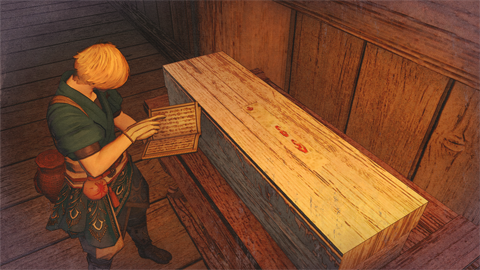
“Once upon a time, there lived a brilliant onmyoji. His enchantments were famed far and wide─yet the man was cursed with a poor memory, and often misplaced the tools he had imbued with such awesome power. Well aware of his foibles, the onmyoji resolved never to let his pieces escape him again, and wrought enchanted strongboxes to safely store them.
This strategy was put to the test when, one evening, a thief attempted to steal his most valuable tools away, boxes and all. Alas, though the vessels faithfully returned to the onmyoji's side, the poor man was distraught to discover that none of the works within had done the same.
Tokimori tells me that several such strongboxes were once present at Shojo Temple. Their magicks inhibited the spiritual powers of the objects sealed within─objects including a bloodthirsty sword and a dogu figurine. I myself managed to claim the box with the aforementioned sword, though the dogu must have been lost in the chaos that claimed the mountain.
While “bloodthirsty sword” rather speaks for itself, I was curious as to why a simple clay figurine should need to be sealed away. It transpires that the dogu, too, is a powerful tool, once used to ensure the temple's sacred trees flourish. Through the simple ritual of bowing before a small shrine and placing the dogu on the altar within, the monks could coax it into enlivening the surrounding greenery. Similarly, disregard for its care may prompt the dogu to wreak havoc on its environs...in which case, it may be best to enshrine any dogu we encounter.
— Entry 1 of 12
The Crimson Sword

“Long ago, in the days when war and strife plagued Hingashi, there lived a man who built his legacy upon a mountain of enemy corpses. Fiercer than a mad tiger, Moko the Restless emerged victorious from every skirmish─but his might would be his undoing.
Fearing that the warrior would rebel against him, Moko's liege lord ordered him slain in the dead of night. The deed was carried out with Moko's own blade, which, having cleanly severed its master's head, soon began to burn red. None could say whether this crimson aura was begat by the warrior's lingering fury or the ire of his victims, but it resisted all efforts to remove it. In a last, desperate attempt to purify the sword, the lord's servants carried it to a sacred peak and plunged it into the holy waters...only for the weapon to devour the font's spiritual energies. From that moment on, any soul who attempted to wield the blade was consumed by murderous rage.
Tokimori claimed that the holy waters in the tale might be found on Mount Rokkon itself, where a lake of particular spiritual power lies concealed. A small shrine allegedly graces its banks, and I cannot help but wonder if treasure hides within. Unfortunately, the path is a closely guarded secret known only to the highest-ranking monks, so we are left to fumble in the dark.
— Entry 2 of 12
A Tale of Dead Men
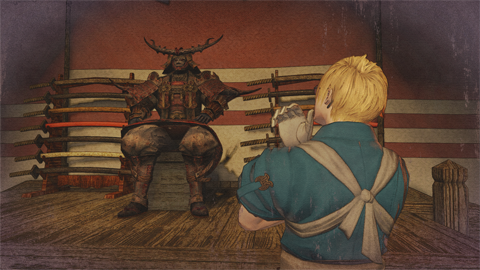
“Moko was a warrior of peerless skill: a boon to his allies and a scourge upon his enemies. After his death, his armor was returned to his kin, who would preserve it as a treasured heirloom for generations to come...until one fateful morn.
As the sun bathed the eastern skies in gold, Moko's descendants rose to find the armor not in the storehouse where it had been secured, but on prominent display in the gardens, stained black with cooling blood. Next to it lay the corpse of a man─a would-be thief struck down by a righteous spirit, most were quick to believe. The family, however, was less than certain. Who was to say when Moko might rise again to sate his bloodlust? Thus, though it pained them to do so, they placed the armor in the care of Shojo Temple, hoping that its hallowed halls would bring the restless general some semblance of peace.
Far Eastern folklore speaks of myriad kami, and of the spirits to be found in all things. One may assume this concept arose from the countless strange creatures found on our star: from voidsent to auspices, and soulkin golems to elemental sprites, nature's capacity for oddity is boundless. Was Moko's armor, then, an unusual form of a known entity, or did it truly play host to the soul of the man that once wore it? Whatever the case, we can be certain that its exposure to Mount Rokkon's aether only emboldened─and enlarged─it. I find myself thankful that we did not share in the alleged thief's fate.
— Entry 3 of 12
Forging a Legacy
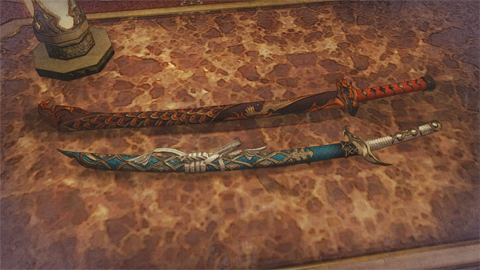
“Though Hingashi has its fair share of celebrated artisans, few tales stoke the flames of a journeyman's ambition like that of Nanakusa, whose blades in the image of the Four Lords saw him rise from humble village blacksmith to renowned forgemaster. Having been on the business end of the swords representing Suzaku and Seiryu during our confrontation with Moko the Restless, to their fine and fearsome quality I can attest. Though I have not yet had the pleasure of an introduction to the Byakko-inspired Hakutei, it in particular is oft spoken of as a weapon to rival one of the greatest the star has to offer: the Swell.
Following his rise to prominence, Nanakusa established a forge near Mount Rokkon. According to Mistress Tsubaki, many an aspiring smith followed in his footsteps, and northeastern Shishu has become something of a haven for these masters of forge and flame. Naturally, they revere the kami of fire, and celebrate their god by way of various spectacular matsuri. In the most prominent of these─its name roughly translating to the “Festival of Three Lanterns”─local blacksmiths seek to imbue the works of past, present, and future with the fire kami's power through lighting a trio of specially crafted lanterns. Of course, this temporal symbolism is only one aspect of the number three's significance to Far Eastern tradition at large.
— Entry 4 of 12
The Luthier and the Songstress
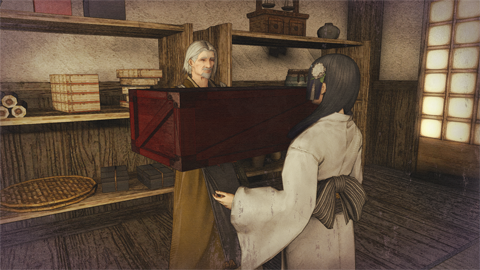
“Once upon a time, there lived a nameless luthier, who poured his heart and soul into building a beautiful biwa. His efforts were not in vain, for the biwa's craftsmanship was immaculate─so much so that he found he could not bear to see it in the hands of a common bard. Season upon season passed as he searched for a soul befitting the biwa's brilliance.
It was not until the luthier's twilight years that a worthy songstress at last entered his workshop. The young woman played for him a song as breathtaking as the autumn moon, and he gladly entrusted her with his life's work. Her ephemeral ballads would capture hearts across Hingashi─until the eve that the luthier's tale came to an end. Neither she nor the biwa have been seen since, leaving her audience to wonder if she was the tsukumogami of the biwa all along.
I have come to learn that tsukumogami can take many forms. Depending on how they manifest, they might bestow a thousand blessings or a thousand curses upon the world. If a tsukumogami is rumored to reside within a prized vessel, its value rises exponentially...but only should it be as benevolent as the songstress in our tale. Were a treasure possessed of a spirit more malevolent, one would do well to exorcise it ere putting it to market.
— Entry 5 of 12
Lost to Avarice
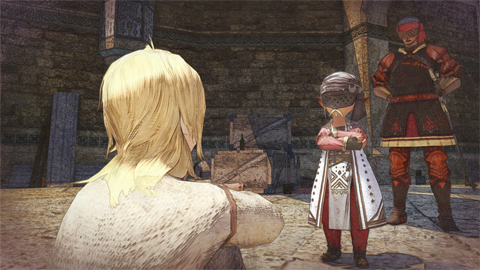
“Long ago, in a remote village, there lived a devout young woman. Though her fields were barren and her rice stores lay empty, she honored the kami at every opportunity, decorating their shrines with what meager offerings she could until, one fateful evening, a divine being appeared to her in a dream. She awoke the next morning to find a wooden hammer next to her pillow. In offering thanks to the kami that day, she swung her newfound hammer, and where it fell, rice gushed forth from the ground like water.
The gods had saved this woman from hunger and granted her endless wealth, but as time passed, she forgot her humble origins. She grew complacent in her prayers, and lost herself in excess. Eventually, rumors of her extravagance spread across the land, and reached the ears of a wicked oni. He stole the hammer for his own selfish purposes, prying the divine gift from the woman's cold, dead fingers.
As a merchant, my first thought upon hearing this tale was of gil, though one does not require divine intervention to make a profit. I am reminded of my first encounter with Chairman Lolorito on the backstreets of Ul'dah:
“I hear tell that you are not entirely bereft of wit,” he said, placing a heavy sack of coin before me. “Take this gil and double it─I shall return in one day.”
I knew very well who I was dealing with. I turned that profit with pride, handed him two very heavy sacks of gil the next day...and found my fortune, as it were. Had I squandered that coin as the young woman did her own gift, I fear I would have been dogged by much worse than demons.
— Entry 6 of 12
Beyond the Lanterns' Light
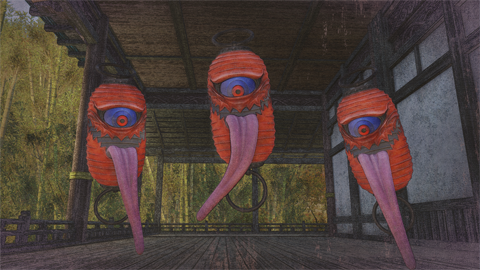
“It was a moonless and cloudy night... A small patrol of samurai was treading a shadowed path when, in the distance, they sighted the warm glow of a lantern. Knowing no honest man would be skulking about at this hour, they approached with caution─to find no man at all, but a single lantern, lying lonely and unattended. With some thought of preventing a fire, one of the samurai reached down to claim it.
In an instant, the samurai were surrounded. A crowd of cold, otherworldly flames hovered just out of arms' reach, as if taunting. Fiendish laughter echoed in the distance, then closer... Yet a mere moment later, the flames disappeared as though nothing had ever transpired. Darkness enveloped the path once again.
There are few in Hingashi who have not heard tales of the bake-chochin. Though these haunting lanterns typically seek only to play tricks on those that wander too close, the ones we encountered on Mount Rokkon clearly had a mind to give chase. According to Tokimori, generations of head monks at Shojo Temple carried a lantern of identical appearance on their nightly strolls, so perhaps the bake-chochin sought merely to protect their masters' home, albeit in a unique way.
The lantern now in my possession bears the following words in Far Eastern calligraphy:
If fortune you seek
Know that our light glows brightest
Within twilight's reach
And 'tis the kami of fire
This celebration entreats
I know not precisely what this poem calls upon its reader to do, but its words occupy my thoughts nonetheless.— Entry 7 of 12
The Common Man's Courage

“Long ago, in a small village in the shadow of Mount Rokkon, there lived a young man. Few were as diligent at harvest time as he─and none so quick to leap into action on the fateful day that screams rang across the fields. Swallowing his fear, he followed the sound to find his neighbors beset by a beast of terrible countenance, its unnatural form proving it the very man-eating monster that had terrorized the people of Shishu for moons. And so, knowing lives would be lost to even a moment's hesitation, the young man lobbed his pitchfork at the creature's exposed belly. It turned tail and ran for the cover of the mountain, howling in pain. Ever since, the village has held a yearly event dedicated to tossing their tools at bundles of straw, in a form of ritual that doubles as useful practice in the event that the kami are slow to respond to future incidents.
Imagine my surprise when, having recovered that fork of legend, I discovered the famed swordsmith Nanakusa's mark upon it. Two histories for the price of one! I suppose all artisans must pay their dues, be it in humble pitchforks or those kettles that Rowena has such a tidy monopoly on, but the contrast between this tool and Nanakusa's more whimsical works is striking. One would never guess that its maker would go on to build Shishu's most expansive smithy, guarded in each cardinal direction by statues of the Four Lords...
— Entry 8 of 12
Sound of the Stone
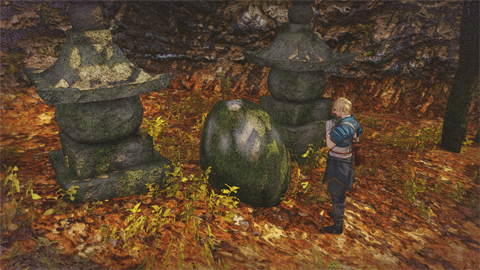
“Given their function as a spiritual bulwark against the earthquakes that plague Hingashi, stones of protection are far from unique to Mount Rokkon. One tale connected to them, however, certainly reflects its unusual history.
Legend has it that a warrior of some renown once visited the mountain as a pilgrim. During his soul-cleansing climb up its slopes, he put his hands together to pray at a stone of protection. In that very moment, a twisted beast leapt from the shadows. It was injured, a pitchfork protruding from its belly, but regardless of circumstance, the warrior could hardly ignore its attempts to tear his head from his body. He plunged his trusty blade into the creature, which thrashed violently in response, colliding with the nearby stone. Ominous peals resounded from the earth below. In alarm, the warrior lost hold of his weapon, while the beast escaped into the foliage and out of sight. Fearing an earthquake was indeed imminent, he carefully wiped the beast's blood from the stone, and all was silent once more.
There are several variants of this legend: in one, the warrior slays the beast, while another insists that it was the creature's bloodcurdling cry that set the earth to rumbling. Still other tales present natural disasters themselves as divine─or at least preternatural─entities. All contain at least a grain of truth, for the fears of a population constantly under threat by events outside its control are very real.
If one theory out of the Studium is to be believed, the stones' protective power may also be more than superstition. The gist, I recall, is that stones of protection are a form of magical focus not dissimilar to nouliths, and thus can stabilize aetherial currents when placed at confluences. Alas, I remember naught of the finer details─beyond their being rather dull.
— Entry 9 of 12
The Seal of Silence

“Ascetics have long availed themselves of Mount Rokkon's solitude to train mind and spirit, and this day was no different. The breeze was still, the trees silent, and the monk of concern to our tale was deep in peaceful meditation when he heard the rustling of grass. Rousing from his contemplations, he opened his eyes to see who had business of such import as to interrupt his tranquility...and came face-to-face instead with a twisted beast. If its form left any doubt to its identity, the weapons lodged in its flesh confirmed that it was Shishio, king among nue and terror to the smallfolk. Though the thought of ending a life─much less that of a creature struggling, despite deep wounds, to survive─was abhorrent, so too was the thought of letting this devourer of men go free. He readied his holy staff, and struck at the mononoke.
The battle was a fierce one, but the monk had the upper hand. To draw the conflict to a close, he struck his staff into Shishio, turning it to stone. He would go on to found Shojo Temple, that a watch might be kept over the now-silent mononoke, and its seal remain unbroken evermore─or so the legends say.
Holy staves such as the monk wielded are quite unlike those of Western mages. Not only do they hold the particular power to purge fell magicks via sound, their use as physical weapons goes far beyond unsophisticated bludgeoning. Though I sadly lack the skill to make use of such awesome power, I find myself considering more mundane applications. In climbing Mount Rokkon, even well-trained ascetics surely find themselves in need of additional support from time to time. Should we need to scale the peak once again, or should an inconvenient wall or pile of boxes stand in our way, I shall be perfectly equipped for the challenge.
— Entry 10 of 12
Seasons of the Fleeting
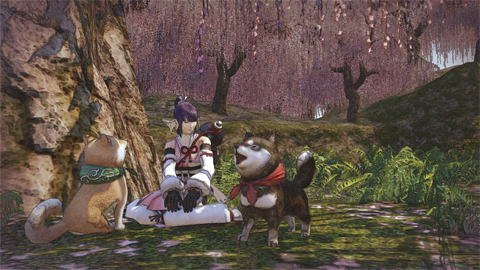
“Long ago and far away, an onmyoji found himself bereft of his beloved wife. Years upon years passed, the cherry tree they planted to celebrate their union bearing fewer blossoms every spring, yet still, the grief of her passing remained fresh. Though left with little hope for himself, the onmyoji prayed the tree, at least, might recover.
To his great surprise, these prayers were answered by his wife herself, for in life she too had been an onmyoji, and had left behind a finely made dogu. At his plea, it began to shine with the power of life itself, reviving the tree's withered boughs in an instant. Understanding now that their love was everlasting, no matter how fleeting their time together, the onmyoji too was filled with newfound vigor, and happily devoted himself to caring for the resplendent cherry tree for the rest of his days.
How painful, and how beautiful, that life should be so ephemeral. Upon our return from Mount Rokkon, I could not help but inquire with Tsubaki as to the nature of Mistress Yozakura, whom we encountered under such inauspicious circumstances. It seems she was heir to the Hanagakure style of ninjutsu, thus her way with flowers, and was in service to Lord Uzumibi at the time of her death. Tokimori added that she had been aiding in the evacuation of those trapped at Shojo Temple, and lost her life to a mononoke while pulling a child to safety.
— Entry 11 of 12
The Ogiseru's Fate
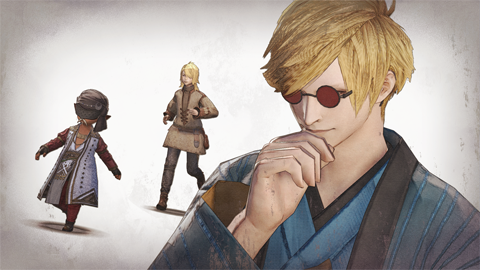
“The great kiseru is rumored to bring similarly great fortune or great calamity to its owner, but I have seen no sign of it possessing a capacity for either thus far. I can but presume that my predecessors sought to credit their trials and tribulations to a single simple cause in a complex and uncertain world. Still, between the power invested in it by such beliefs and the rich aether of the mountain, it would have been shocking had the kiseru not become a tsukumogami, even were it once wholly mundane. But regardless of whether Gorai was blessed to have spent his final days in the company of his beloved collection, or cursed to have suffered the grave consequences, I doubt the pipe alone was the arbiter of his fate.
Though I had what many would consider an “unfortunate” childhood, I never thought myself the victim of ill fate. On the contrary, I believe my acute mercantile sensibilities to be the product of early hardships─instructive steps along a journey that, all things considered, hasn't been half bad. I might've said otherwise at the time had I stopped to weigh my happiness against my unhappiness, but instead I kept moving, and 'tis well that I did. Whether we speak of tangible or intangible fortunes, it matters not what we have, but what we make of it.
— Entry 12 of 12